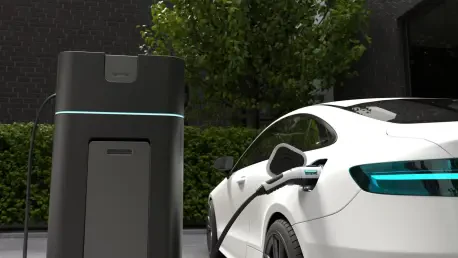In the rapidly evolving landscape of electric vehicle infrastructure, Donald Gainsborough is recognized as a commanding presence in policy and legislation. With his leadership at Government Curated, he steers discussions on federal funding and its implications for the EV sector, providing invaluable insights into the challenges and advancements in building out EV charging networks across the nation. In this interview, we explore the effects of political decisions on EV infrastructure, the disparity between rural and urban charging availability, and the complex interactions between policy and technology in this burgeoning field.
How has the Trump administration’s efforts affected federal funding for electric vehicle charging infrastructure?
The Trump administration’s suspension of the National Electric Vehicle Infrastructure (NEVI) program posed significant challenges to the development of EV infrastructure. By making federal funding difficult to access, it delayed the momentum needed for the expansion of charging networks, particularly in rural areas. Despite this, the charging ports continue to grow, albeit unevenly, across the country, underscoring the resilience of state and local initiatives against political headwinds.
Can you explain the current distribution of fast EV charging ports between rural and metropolitan counties?
Currently, there’s a notable disparity in fast EV charging port distribution between rural and metropolitan counties. As of early 2025, about 45% of rural counties have at least one fast EV charging port, while metropolitan counties stand at a higher 76.5%. This discrepancy highlights the challenges rural areas face in catching up with the infrastructural facilities already prevalent in urban settings.
What are fast charging ports, and how do they differ from other types of chargers?
Fast charging ports, often referred to as DC or level 3 chargers, are designed to charge an electric vehicle in approximately 30 minutes, dramatically reducing the time compared to standard chargers. Unlike Level 1 and Level 2 chargers, which may take several hours, fast chargers are indispensable in meeting the convenience expectations of drivers, especially those on long trips or tight schedules.
Why are rural areas slower to build out EV charging infrastructure compared to urban areas?
The slow deployment of EV charging infrastructure in rural areas can be attributed to lower utilization rates and fewer electric vehicles on the roads, making it less economically viable for private investors. Furthermore, the geographic spread and lower population density in rural areas result in higher costs and logistical challenges when building and maintaining charging stations.
Can you elaborate on the concept of utilization rates for EV charging ports?
Utilization rates measure how much time charging ports are actively used to provide electricity to vehicles. High utilization rates, often seen in urban areas with a substantial number of EVs, reflect frequent use and can indicate the financial viability of a charging station. In contrast, rural areas frequently exhibit low utilization rates, challenging the business case for private investment in charging infrastructure.
What are the challenges faced by rural areas in terms of EV adoption and charging infrastructure?
Rural areas struggle with a “Catch-22” scenario: Few EVs on the road discourage investment in charging infrastructure, yet the scarcity of chargers deters more drivers from switching to EVs. Additionally, rural areas face infrastructure challenges such as the need for extensive site preparation, higher per-unit costs due to lower density, and often limited access to alternative funding sources.
How does the “Rural Charging Catch-22” affect investment in rural EV charging?
This “Catch-22” makes it difficult for rural areas to attract investors since the low number of EV drivers doesn’t justify the costs of building infrastructure. Without government intervention or incentives, private companies find it hard to justify placing charging stations in areas with low anticipated use, perpetuating the cycle of limited EV adoption in these regions.
What utilization rate is required for privately funded charging stations to be financially viable?
For privately funded charging stations to break even, utilization rates typically need to exceed the low twenties. Higher utilization ensures that revenue from the stations can cover operational costs and provide a return on investment, which is a benchmark that most rural areas are currently unable to meet.
How have state and federal programs helped to alleviate challenges in rural EV infrastructure development?
State and federal programs, by offering competitive funding and incentives, play a crucial role in developing EV infrastructure in rural areas. They bridge the gap created by market shortcomings, effectively enabling the build-out where private investment alone would not be feasible. Programs like NEVI, even amidst challenges, demonstrate the potential of targeted funding to unlock new areas for charging infrastructure.
What impact did the suspension of the NEVI program by the Trump administration have on EV infrastructure development?
The suspension led to uncertainty and halted progress in many states, particularly impacting planned expansions in rural areas where infrastructure is most needed. Although the federal pause slowed progress, it highlighted the importance of consistent policy support for advancing EV infrastructure nationwide.
Can you share specific examples of NEVI-funded charging stations in rural areas that have been successful?
In Ohio, NEVI-funded stations have thrived, especially those located along major interstates, illustrating how strategic placement can bolster rural charging infrastructure. These stations have seen a surge in use, particularly during high-traffic periods, effectively supporting the concept of an “American Road Trip” powered by EVs.
How does the geographical location, like the presence of major interstates, affect the buildout of charging stations in rural areas?
Major interstates play a pivotal role in the strategic deployment of charging stations, providing high visibility and usage potential, thus attracting more traffic. Stations situated along key travel corridors typically see higher utilization, making them more attractive investments even in typically underserved rural areas.
What other sources of funding exist for developing EV charging stations besides NEVI?
Besides NEVI, numerous grants, incentives, and tax credits from utilities, federal and state programs aid in offsetting costs associated with the development of charging stations. These funding opportunities often cover a range of expenses from site preparation to hardware rebates, crucially supporting broader EV infrastructure development.
How do make-ready incentives from utilities contribute to the development of EV charging stations?
Make-ready incentives from utilities lower the upfront costs by assisting with the necessary preparations to connect and support charging stations. These programs cover essential site work, sometimes even hardware costs, thus removing barriers that might otherwise dissuade developers from investing in rural areas.
Why is government funding crucial for the expansion of EV infrastructure in rural areas?
Government funding is vital to ensure equitable access to EV infrastructure, much like the efforts of the past with the Rural Electrification Act. Without such public intervention, rural communities may remain underserved due to the lack of economic incentives for private investors, ultimately hindering nationwide EV adoption.
How does the expansion of EV infrastructure compare to historical government initiatives like the Rural Electrification Act?
The expansion mirrors the Rural Electrification Act in its necessity for government intervention to ensure service access across diverse populations. Both require significant public investment to overcome geographic and economic hurdles, aiming to achieve widespread benefits for all citizens, regardless of where they reside.
How have EV sales trends changed in recent years, and how do these trends affect infrastructure development?
EV sales have continued to rise, expanding their share significantly among all vehicle sales. This growth increases demand for charging infrastructure, pressuring both public and private sectors to expand networks rapidly to meet new consumer expectations and accelerate market transition towards electric mobility.
Despite political hurdles, what is the future outlook for EV adoption and infrastructure development in the U.S.?
The outlook remains promising; increased EV adoption is anticipated to drive further infrastructure investments. While political challenges may slow progress, the overall momentum towards electrification seems inevitable, fueled by technological advancements, consumer demand, and ongoing governmental and industry commitment to sustainable transportation solutions.









